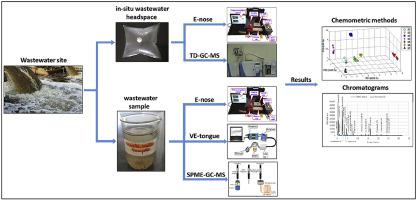Talanta ( IF 5.6 ) Pub Date : 2020-07-31 , DOI: 10.1016/j.talanta.2020.121450 Mohammed Moufid , Michael Hofmann , Nezha El Bari , Carlo Tiebe , Matthias Bartholmai , Benachir Bouchikhi

|
The presence of wastewater and air pollution has become an important risk factor for citizens, not only in terms of problems related to health risks, but also because of its negative impact on the country's image. For this reason, malodorous emission monitoring and control techniques are in high demand in urban areas and industries. The aim of this work is first to build an electronic nose (e-nose) and a Voltammetric Electronic tongue (VE-tongue) in order to study their ability to discriminate between polluted and clean environmental samples. Secondly, Thermal Desorption-Gas Chromatography-Mass Spectrometry (TD-GC-MS), and Solid Phase Micro Extraction-Gas Chromatography–Mass Spectrometry (SPME-GC-MS) are utilized to explain this discrimination by identifying specific compounds from these samples. Indeed, the e-nose, consisted of metal oxide semiconductor gas sensors, is used for the assessment of the studied odorous air and headspace samples from water and wastewater sites. Moreover, the VE-tongue, based on metal electrodes, is utilized to determine the patterns of the sensor array responses, which serve as fingerprints profiles of the analyzed liquid samples. Chemometric tools, such as Principal Component Analysis (PCA), Hierarchical Cluster Analysis (HCA), and Support Vector Machines (SVMs) are operated for the processing of data from the e-nose and the VE-tongue. By using the both systems, the analyses of headspace and liquid samples from the seven sites allow better discrimination. To explain the cause of the obtained discrimination, TD-GC-MS and SPME-GC-MS analyses are well performed to identify compounds related sites. According to these outcomes, the proposed e-nose and VE-tongue are proved to be rapid and valuable tools for analysis of environmental polluted matrices.
中文翻译:

通过电子鼻,VE-舌,TD-GC-MS和SPME-GC-MS进行废水监测
废水和空气污染的存在已成为公民的重要风险因素,不仅在与健康风险有关的问题方面,而且由于其对国家形象的负面影响。因此,在城市地区和工业中对恶臭排放监测和控制技术的需求很高。这项工作的目的是首先建立一个电子鼻(e-nose)和一个伏安电子舌(VE-tongue),以研究它们区分污染和清洁环境样品的能力。其次,利用热脱附-气相色谱-质谱(TD-GC-MS)和固相微萃取-气相色谱-质谱(SPME-GC-MS)通过从这些样品中鉴定特定化合物来解释这种区别。的确,电子鼻 由金属氧化物半导体气体传感器组成的传感器,用于评估所研究的来自水和废水现场的有气味的空气和顶空样品。此外,基于金属电极的VE舌片可用于确定传感器阵列响应的模式,该模式可作为分析液体样品的指纹图谱。化学计量学工具(例如主成分分析(PCA),层次聚类分析(HCA)和支持向量机(SVM))可用于处理电子鼻和VE舌头的数据。通过使用这两种系统,可以对来自七个位置的顶空和液体样品进行分析,从而更好地进行区分。为了解释获得歧视的原因,可以很好地进行TD-GC-MS和SPME-GC-MS分析,以鉴定化合物相关位点。根据这些结果,









































 京公网安备 11010802027423号
京公网安备 11010802027423号